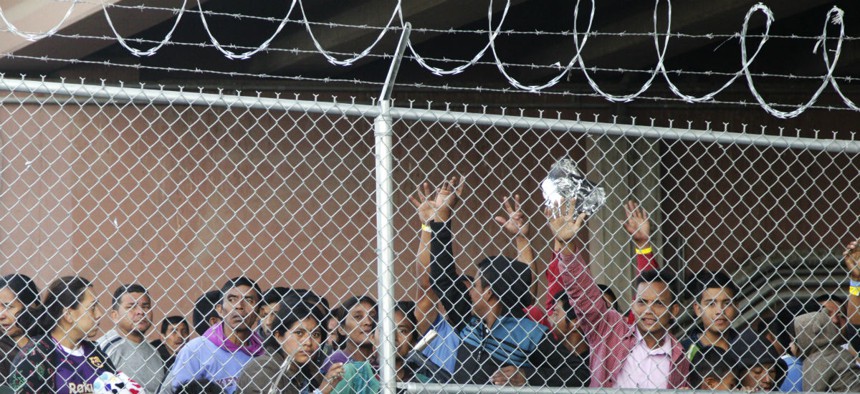
Central American migrants wait for food in El Paso, Texas, on March 27 in a pen erected by CBP to process a surge of migrant families and unaccompanied minors. Cedar Attanasio/AP
DHS Asks More Employees—From Across Government—to Deploy to the Border
Border assignments to begin "immediately," top official says.
The Trump administration doubled down on its proposal shift federal employees out of their normal duties to instead provide support to personnel at the U.S.-Mexico border, saying on Monday it would hasten its reassignments and expand its search for supplemental staff.
Federal agencies are looking for additional employees to assist Border Patrol agents as they respond to an influx of families making asylum claims at the border, Homeland Security Secretary Kirstjen Nielsen said. The statement followed an announcement from Customs and Border Protection Commissioner Kevin McAleenan last week that CBP would reassign 750 customs officers from ports of entry to assist Border Patrol staff.
Nielsen on Monday issued a memorandum to McAleenan instructing him to “explore raising that target,” giving him leeway to reassign up to 2,000 employees before having to seek additional guidance from DHS. The officers will come from field offices at ports of entry in San Diego; Tucson, Ariz.; El Paso and Laredo, Texas. McAleenan previously said those officers would serve in support roles, assisting with processing, transportation and hospital watch.
The commissioner also floated drawing from other parts of CBP, saying the agency would activate individuals at the agency who previously volunteered to serve as part of a surge capacity force following natural disasters. Nielsen expanded that request, saying DHS would “urgently pursue additional reinforcements” from both within the department “and the interagency.”
CBP officials declined to elaborate on how those deployments would work or who it would target for temporary reassignments, pointing only to a statement that 40 percent of Border Patrol agents are currently “diverted away” from normal border security duties to care for, transport and process family units and unaccompanied minors. Nielsen said the redeployment of CBP officers would occur “immediately.”
The target of 750 officers for transfer had already drawn the ire from representatives of the customs employees. Tony Reardon, president of the National Treasury Employees Union, which represents the officers, said CBP is already suffering from a shortfall of employees, noting the agency has 1,600 vacant officer positions. He said the union would work to ensure that temporary assignments are implemented fairly and that affected employees receive adequate housing and compensation.
Reardon said CBP has pledged to rely only on employees volunteering to deploy to the border, and they will be assigned to locations “as close to their homes as possible.” Still, he noted the assignments will have an impact on normal operations.
“Deploying CBP personnel away from the ports of entry will impact port operations, a fact readily acknowledged by CBP management,” Reardon said.
McAleenan did admit the moves would have a negative effect at ports.
“There will be impacts to traffic at the border,” McAleenan said last week. “There will be a slowdown in processing of trade. There will be wait times in our pedestrian and vehicle passenger lanes . . . but this is required to help us manage this operational crisis.”
President Trump over the weekend once again threatened to close the U.S.-Mexico border entirely, potentially freeing up a far greater number of CBP officers to assist Border Patrol agents operating between ports of entry. Trump also said his administration would stop sending aid to El Salvador, Guatemala and Honduras, the countries accounting for the bulk of the surge in families at the border.
Nielsen in recent days sent a letter to lawmakers with an “urgent request” for more resources at the border, saying Homeland Security no longer has the capacity to handle the migrants attempting to cross the southwest border.
“Our men and women on the frontlines are simply not resourced to handle these levels, and I report today that we are struggling to transport and process—let alone adequately care for—this many individuals coming into our custody,” Nielsen said, adding that department staff is “stretched too thin” and the department is facing “a systemwide meltdown.”
Nielsen said she is working with the Office of Management and Budget for an exact supplemental funding request, but it will include at least hundreds of employees and other “emergency resources and specific authorities.” In her announcement on Monday, Nielsen directed CBP to force more asylum seekers to shelter in Mexico while they await a hearing in the United States.
Rep. Bennie Thompson, D-Miss., chairman of the House Homeland Security Committee, did not appear eager to grant Nielsen’s request.
“DHS has the means to process these individuals in an orderly and timely way,” Thompson said. “The administration has no credibility to demand Congress act when it has acted in bad faith on this issue since day one.” He added he would support resources only to ensure humane treatment of migrants.
CBP has apprehended nearly 52,000 families this month, more than 10 times the average apprehended in March during the previous five years. It has apprehended 268,000 total individuals so far in fiscal 2019, which began Oct. 1, 2018, compared to 397,000 the previous year.
The employment surges come as the Border Patrol seeks to drastically expand its own workforce, something it has failed to do in recent years, despite having the authority. In 2018, the agency for the first time in several years added more employees than it lost, but that resulted in a net gain of just three agents at the Southwest border. In the early days of his administration, President Trump called on the Border Patrol to add 5,000 new agents to the ranks. CBP signed a contract with Accenture worth up to $300 million to help achieve that goal, but the agency was recently forced to dramatically scale that back after it failed to lead to any significant hiring.







